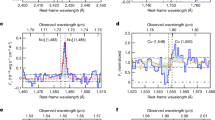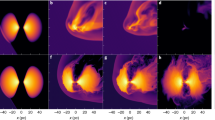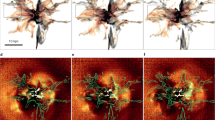Abstract
Supermassive black holes in galaxy centres can grow by the accretion of gas, liberating energy that might regulate star formation on galaxy-wide scales1,2,3. The nature of the gaseous fuel reservoirs that power black hole growth is nevertheless largely unconstrained by observations, and is instead routinely simplified as a smooth, spherical inflow of very hot gas4. Recent theory5,6,7 and simulations8,9,10 instead predict that accretion can be dominated by a stochastic, clumpy distribution of very cold molecular clouds—a departure from the ‘hot mode’ accretion model—although unambiguous observational support for this prediction remains elusive. Here we report observations that reveal a cold, clumpy accretion flow towards a supermassive black hole fuel reservoir in the nucleus of the Abell 2597 Brightest Cluster Galaxy (BCG), a nearby (redshift z = 0.0821) giant elliptical galaxy surrounded by a dense halo of hot plasma11,12,13. Under the right conditions, thermal instabilities produce a rain of cold clouds that fall towards the galaxy’s centre14, sustaining star formation amid a kiloparsec-scale molecular nebula that is found at its core15. The observations show that these cold clouds also fuel black hole accretion, revealing ‘shadows’ cast by the molecular clouds as they move inward at about 300 kilometres per second towards the active supermassive black hole, which serves as a bright backlight. Corroborating evidence from prior observations16 of warmer atomic gas at extremely high spatial resolution17, along with simple arguments based on geometry and probability, indicate that these clouds are within the innermost hundred parsecs of the black hole, and falling closer towards it.
This is a preview of subscription content, access via your institution
Access options
Subscribe to this journal
Receive 51 print issues and online access
$199.00 per year
only $3.90 per issue
Buy this article
- Purchase on Springer Link
- Instant access to full article PDF
Prices may be subject to local taxes which are calculated during checkout




Similar content being viewed by others
References
McNamara, B. R. & Nulsen, P. E. J. Heating hot atmospheres with active galactic nuclei. Annu. Rev. Astron. Astrophys. 45, 117–175 (2007)
McNamara, B. R. & Nulsen, P. E. J. Mechanical feedback from active galactic nuclei in galaxies, groups and clusters. New J. Phys. 14, 055023 (2012)
Fabian, A. C. Observational evidence of active galactic nuclei feedback. Annu. Rev. Astron. Astrophys. 50, 455–489 (2012)
Bondi, H. On spherically symmetrical accretion. Mon. Not. R. Astron. Soc. 112, 195–204 (1952)
Pizzolato, F. & Soker, N. On the nature of feedback heating in cooling flow clusters. Astrophys. J. 632, 821–830 (2005)
Voit, G. M., Donahue, M., Bryan, G. L. & McDonald, M. Regulation of star formation in giant galaxies by precipitation, feedback and conduction. Nature 519, 203–206 (2015)
Voit, G. M., Bryan, G. L., O’Shea, B. W. & Donahue, M. Precipitation-regulated star formation in galaxies. Astrophys. J. 808, L30 (2015)
Sharma, P., McCourt, M., Quataert, E. & Parrish, I. J. Thermal instability and the feedback regulation of hot haloes in clusters, groups, and galaxies. Mon. Not. R. Astron. Soc. 420, 3174–3194 (2012)
Gaspari, M., Ruszkowski, M. & Oh, S. P. Chaotic cold accretion on to black holes. Mon. Not. R. Astron. Soc. 432, 3401–3422 (2013)
Li, Y. & Bryan, G. L. Modeling active galactic nucleus feedback in cool-core clusters: the formation of cold clumps. Astrophys. J. 789, 153 (2014)
McNamara, B. R. et al. Discovery of ghost cavities in the X-ray atmosphere of Abell 2597. Astrophys. J. 562, L149–L152 (2001)
Clarke, T. E., Sarazin, C. L., Blanton, E. L., Neumann, D. M. & Kassim, N. E. Low-frequency radio observations of X-ray ghost bubbles in A2597: a history of radio activity in the core. Astrophys. J. 625, 748–753 (2005)
Tremblay, G. R. et al. Multiphase signatures of active galactic nucleus feedback in Abell 2597. Mon. Not. R. Astron. Soc. 424, 1026–1041 (2012)
Gaspari, M., Brighenti, F. & Temi, P. Chaotic cold accretion on to black holes in rotating atmospheres. Astron. Astrophys. 579, A62 (2015)
Tremblay, G. R. et al. Residual cooling and persistent star formation amid active galactic nucleus feedback in Abell 2597. Mon. Not. R. Astron. Soc. 424, 1042–1060 (2012)
O’Dea, C. P., Baum, S. A. & Gallimore, J. F. Detection of extended H I absorption toward PKS 2322–123 in Abell 2597. Astrophys. J. 436, 669–677 (1994)
Taylor, G. B., O’Dea, C. P., Peck, A. B. & Koekemoer, A. M. H I Absorption toward the nucleus of the radio galaxy PKS 2322–123 in A2597. Astrophys. J. 512, L27–L30 (1999)
O’Dea, C. P., Baum, S. A., Mack, J., Koekemoer, A. M. & Laor, A. Hubble Space Telescope STIS far-ultraviolet observations of the central nebulae in the cooling-core clusters A1795 and A2597. Astrophys. J. 612, 131–151 (2004)
Oonk, J. B. R., Hatch, N. A., Jaffe, W., Bremer, M. N. & van Weeren, R. J. Far-ultraviolet emission in the A2597 and A2204 brightest cluster galaxies. Mon. Not. R. Astron. Soc. 414, 2309–2336 (2011)
Tremblay, G. R. et al. Far-ultraviolet morphology of star-forming filaments in cool core brightest cluster galaxies. Mon. Not. R. Astron. Soc. 451, 3768–3800 (2015)
Salomé, P. et al. A very extended molecular web around NGC 1275. Astron. Astrophys. 531, A85 (2011)
Jaffe, W., Bremer, M. N. & Baker, K. H II and H2 in the envelopes of cooling flow central galaxies. Mon. Not. R. Astron. Soc. 360, 748–762 (2005)
Salomé, P. et al. Cold molecular gas in the Perseus cluster core. Association with X-ray cavity, Hα filaments and cooling flow. Astron. Astrophys. 454, 437–445 (2006)
Smith, E. P., Heckman, T. M. & Illingworth, G. D. Stellar dynamics of powerful radio galaxies. Astrophys. J. 356, 399–415 (1990)
Larson, R. B. Turbulence and star formation in molecular clouds. Mon. Not. R. Astron. Soc. 194, 809–826 (1981)
Solomon, P. M., Rivolo, A. R., Barrett, J. & Yahil, A. Mass, luminosity, and line width relations of Galactic molecular clouds. Astrophys. J. 319, 730–741 (1987)
Wiklind, T. & Combes, F. Molecular absorption and its time variations in Centaurus A. Astron. Astrophys. 324, 51–64 (1997)
Espada, D. et al. Disentangling the circumnuclear environs of Centaurus A. II. On the nature of the broad absorption line. Astrophys. J. 720, 666–678 (2010)
David, L. P. et al. Molecular gas in the X-ray bright group NGC 5044 as revealed by ALMA. Astrophys. J. 792, 94 (2014)
Urry, C. M. & Padovani, P. Unified schemes for radio-loud active galactic nuclei. Publ. Astron. Soc. Pacif. 107, 803–845 (1995)
Voit, G. M. & Donahue, M. A deep look at the emission-line nebula in Abell 2597. Astrophys. J. 486, 242 (1997)
Bolatto, A. D., Wolfire, M. & Leroy, A. K. The CO-to-H2 conversion factor. Annu. Rev. Astron. Astrophys. 51, 207–268 (2013)
McNamara, B. R. et al. A 1010 solar mass flow of molecular gas in the A1835 brightest cluster galaxy. Astrophys. J. 785, 44 (2014)
Russell, H. R. et al. Massive molecular gas flows in the A1664 brightest cluster galaxy. Astrophys. J. 784, 78 (2014)
Acknowledgements
ALMA is a partnership of ESO (representing its member states), NSF (USA) and NINS (Japan), together with NRC (Canada) and NSC and ASIAA (Taiwan), in cooperation with the Republic of Chile. The Joint ALMA Observatory is operated by ESO, AUI/NRAO and NAOJ. We are grateful to the European ALMA Regional Centres, particularly those in Garching and Manchester, for their dedicated end-to-end support of data associated with this paper. We thank R. Larson for discussions. G.R.T. acknowledges support from National Aeronautics and Space Administration (NASA) through Einstein Postdoctoral Fellowship Award Number PF-150128, issued by the Chandra X-ray Observatory Center, which is operated by the Smithsonian Astrophysical Observatory for and on behalf of NASA under contract NAS8-03060. F.C. acknowledges the European Research Council (ERC) for the Advanced Grant Program no. 267399-Momentum. B.R.M. is supported by a grant from the Natural Sciences and Engineering Research Council of Canada. T.A.D. acknowledges support from a Science and Technology Facilities Council (STFC) Ernest Rutherford Fellowship. A.C.E. acknowledges support from STFC grant ST/L00075X/1. A.C.F. and H.R.R. acknowledge support from ERC Advanced Grant Program no. 340442-Feedback. M.N.B. acknowledges funding from the STFC. Basic research in radio astronomy at the Naval Research Laboratory is supported by 6.1 Base funding.
Author information
Authors and Affiliations
Contributions
G.R.T. was principal investigator on the original proposal, performed the data analysis, and wrote the paper. J.B.R.O., T.A.D., R.G.M. and A.M. were substantially involved in planning both scientific and technical aspects of the proposal, while T.A.D. and R.G.M. contributed ALMA data reduction and analysis expertise once the data were obtained. J.B.R.O., F.C. and P.S. invested substantial time in analysis of the data. Substantial scientific feedback was also provided over many months by F.C., J.B.R.O., C.P.O., S.A.B., G.M.V., M.D., B.R.M., M.A.M., T.E.C., H.R., A.C.E. and A.C.F., while all other co-authors discussed the results and commented on the manuscript.
Corresponding author
Ethics declarations
Competing interests
The authors declare no competing financial interests.
Additional information
This paper makes use of the following ALMA data: ADS/JAO.ALMA#2012.1.00988.S.
Source data
Rights and permissions
About this article
Cite this article
Tremblay, G., Oonk, J., Combes, F. et al. Cold, clumpy accretion onto an active supermassive black hole. Nature 534, 218–221 (2016). https://doi.org/10.1038/nature17969
Received:
Accepted:
Published:
Issue Date:
DOI: https://doi.org/10.1038/nature17969
This article is cited by
-
The formation of dusty cold gas filaments from galaxy cluster simulations
Nature Astronomy (2020)
-
Linking macro-, meso- and microscales in multiphase AGN feeding and feedback
Nature Astronomy (2020)
-
Observational constraints on the feeding of supermassive black holes
Nature Astronomy (2019)
-
Hot Atmospheres, Cold Gas, AGN Feedback and the Evolution of Early Type Galaxies: A Topical Perspective
Space Science Reviews (2019)
-
The interstellar and circumnuclear medium of active nuclei traced by H i 21 cm absorption
The Astronomy and Astrophysics Review (2018)
Comments
By submitting a comment you agree to abide by our Terms and Community Guidelines. If you find something abusive or that does not comply with our terms or guidelines please flag it as inappropriate.



